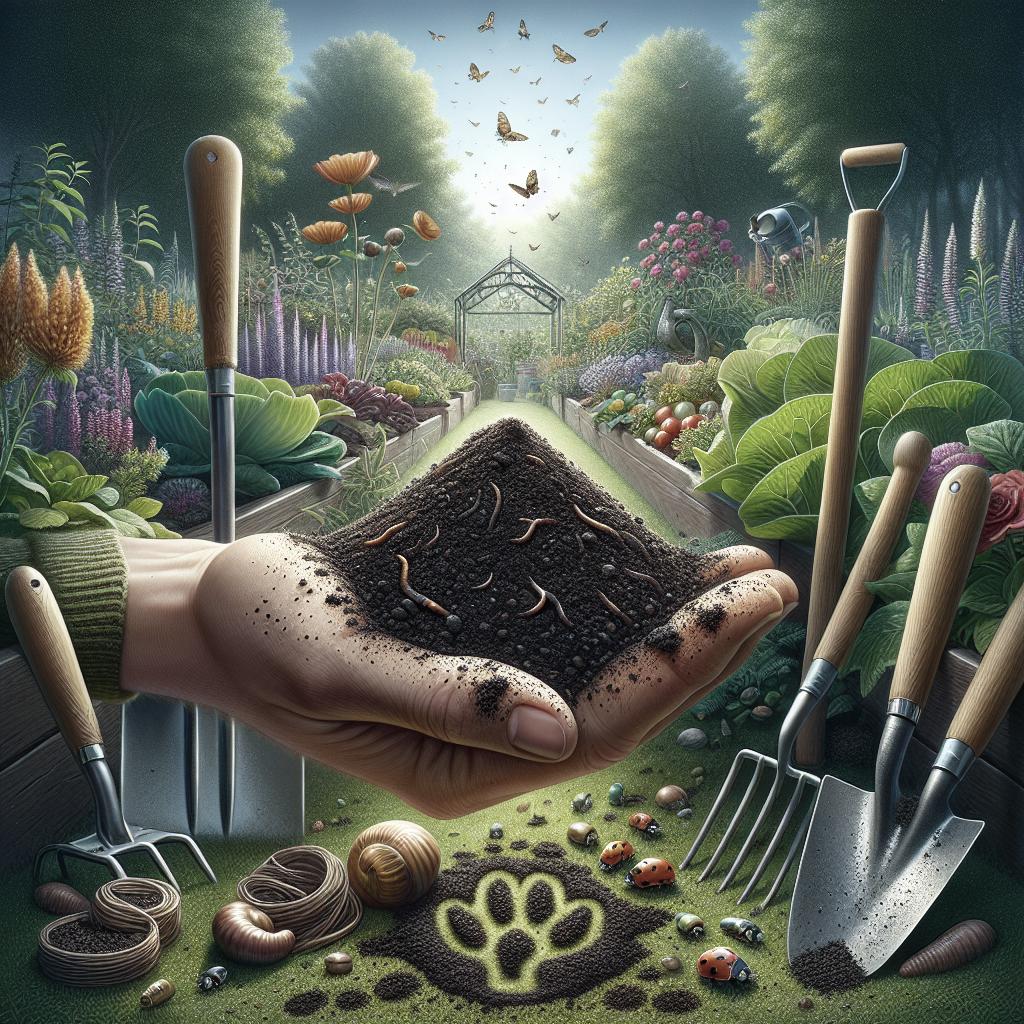“`html
The Signs of Healthy Soil in Gardening
In gardening, the key to success often lies beneath our feet, within the soil that supports plant life. Understanding the signs of healthy soil is crucial to fostering robust gardens. This guide unpacks various characteristics of healthy soil, including its texture, structure, drainage, and biological life. By examining visual soil tests and evaluating the correlations between soil practices and outcomes, gardeners can improve their soil’s health. The insights offered here aim to refine future soil management strategies and promote sustainable gardening practices.
Background
Gardening enthusiasts and professionals alike understand that soil health is the bedrock of successful plant growth. Soil serves as both the physical and nutrient base for plants, influencing their development, resilience, and yield. The characteristics of healthy soil often go unnoticed until plants start showing signs of deficiency.
Recognizing these signs early, therefore, plays a crucial role in any gardener’s skill set. Healthy soil is not just about fertility but encompasses an array of qualities including its structure, texture, and biological content. This article will discuss the various indicators that denote soil health, thereby equipping gardeners with the knowledge to cultivate thriving gardens.
Aims of this experiment
The purpose of this experiment is to identify and evaluate the various signs that indicate healthy soil within a gardening context. By doing so, gardeners and horticulturalists can enhance their approaches to soil management, leading to better plant health and productivity.
Another aim is to bridge the gap between theoretical knowledge and practical approaches to soil health. As we dig deeper into the characteristics and tests for soil health, this experiment is designed to equip readers with actionable insights to assess and improve their garden soils.
Healthy Soil Characteristics
Healthy soil is the cornerstone of any thriving garden. It provides essential nutrients, retains water well, and supports a complex ecosystem of organisms that contribute to plant health. But what makes soil healthy, and how can we identify it?
Some defining characteristics of healthy soil include a balanced texture that facilitates both water retention and drainage, a rich composition of organic matter, and signs of biological activity such as earthworm presence. Understanding these characteristics can help gardeners make informed decisions about soil management.
Three Main Types of Soil
Soil types are broadly classified into three categories: sandy, clay, and loamy. Each has its unique traits affecting gardening practices. Sandy soil, for instance, is known for its excellent drainage but poor nutrient retention.
Clay soil, on the other hand, retains water and nutrients well but struggles with drainage issues. Loamy soil is often considered ideal for gardening because it balances the benefits of clay and sand, providing optimal conditions for plant growth. Recognizing these types helps gardeners adjust their practices for the best results.
Soil texture
Soil texture refers to the proportion of sand, silt, and clay particles in soil. It greatly influences water absorption, nutrient availability, and root penetration, affecting overall plant health.
A well-balanced soil texture—typically loam—provides adequate aeration and holds moisture well, ensuring that plants receive a steady supply of water and nutrients. Gardeners can assess soil texture by feeling it; an ideal soil should be crumbly and easy to work with.
Soil structure
Beyond texture, soil structure pertains to the arrangement of soil particles into aggregates or clusters, affecting how easily roots can penetrate the soil and access vital resources.
A good soil structure facilitates better air and water movement, promoting faster plant growth. It’s often loosely packed with visible pores, allowing roots to explore freely and absorb necessary nutrients from their environment.
Soil drainage
Effective soil drainage is vital as it prevents water from pooling around plant roots, which can lead to root rot and other issues. Ideal soil allows water to filter through at a moderate rate—neither too fast nor too slow.
Soil that drains well will maintain moisture levels needed to keep plants healthy without waterlogging. Assessing soil drainage is crucial in adapting gardening practices to maintain plant health and robust growth.
Soil organic matter content
Organic matter is crucial to soil health as it enriches the soil with nutrients and improves its water-holding capacity. It also supports microorganisms essential for breakdown processes and nutrient cycling.
High levels of organic matter enhance soil fertility and structure, contributing to sustained plant growth. Incorporating compost and other organic materials can significantly boost the organic matter content in garden soil.
Biological life
The presence of living organisms in soil is a prime indicator of its health. A biodiverse ecosystem within the soil contributes to nutrient cycling, disease suppression, and soil structure enhancement.
Earthworms, insects, fungi, and bacteria are key players in maintaining soil health. Their activities aerate the soil and enhance nutrient availability for plants, making biological life a crucial component of healthy soil.
Biological activity
Soil organic matter
Organic matter fuels the activities of soil organisms, which in turn transform and release nutrients essential for plant growth. The decomposition process carried out by these organisms improves soil structure and fertility.
Earthworms
The presence of earthworms is a hallmark of good soil health. They aerate the soil as they move through it, improving air and water circulation. Their activity also breaks down organic material, enriching the soil with their castings.
Visual weeds test
While often considered nuisances, weeds can provide insights into soil health. Specific weeds thrive in particular soil conditions; for example, chickweed often indicates compacted soil with high fertility.
Visual Soil Tests
Surface crusting test
Surface crusting occurs when the soil surface hardens, preventing water infiltration and seedling emergence. Examining this can indicate issues with soil structure or texture that need addressing.
Surface ponding
Surface ponding signifies poor drainage, where water remains on the soil surface. This test can highlight drainage inefficiencies needing resolution for better plant root health and growth.
Smell test
A healthy soil typically emits a pleasant earthy smell due to the presence of soil microorganisms. A sour or unpleasant smell might hint at anaerobic conditions or decay, requiring intervention.
Potential rooting depth
This test involves digging a hole to observe root growth. Shallow roots can suggest soil compaction or poor structure, whereas deep roots often indicate favorable soil conditions.
Fork test
A fork test helps in assessing soil compaction. By inserting a fork into the soil, one can evaluate compaction levels; dense, hard-to-penetrate soil may require aeration improvements.
Observations
Through diligent observation and testing, valuable insights into soil conditions can be obtained. Recognizing the intricate signs of healthy soil through tests like visual inspections and organism counts can direct fertilization and amendment strategies.
Observational insights provide gardeners the needed data to modify soil management techniques. Recording these observations over time can reveal trends and assist in forecasting future soil health needs.
Results
The findings of these tests illuminate the direct relationship between soil characteristics and plant health. Healthy soil displays optimum scores across texture, drainage, structure, and biological activity indicators.
Results often show that soil amelioration efforts—such as organic matter additions or changing tillage practices—lead to healthier, more fertile soils conducive to sustainable gardening practices.
Correlations between soil practices and soil visual test scores
There is a strong correlation between soil management practices and the outcomes of visual soil tests. For instance, high scores in drainage tests often relate to the integration of organic matter, which improves soil structure.
Enhancing soil biology through the limitation of chemical treatments can increase a soil’s visual test scores, reflecting improved health and vitality. Understanding these correlations aids gardeners in refining their soil treatment approaches.
Tips for Improving Soil
Additions to the soil
Incorporating organic materials such as compost and mulch enriches soil with nutrients, improving its fertility and structure. Regular additions can significantly enhance soil health over time.
Cultivations
Regular cultivation practices like tilling can help break up compacted soil and incorporate organic material more uniformly. However, they should be balanced to prevent soil degradation and erosion.
Use of green manures
Green manures are cover crops cultivated for the express purpose of enhancing soil health. Once they decompose, they add organic matter and improve soil structure.
Soil texture
Improving soil texture may involve amending it with sand, clay, or loam to achieve a better balance. Such amendments help in optimizing water retention and nutrient availability.
Soil structure
Consistently adding organic matter and practicing minimal tillage can improve soil structure by fostering aggregate formation. This helps in creating a more porous and friable soil environment.
Soil porosity
Soil porosity can be enhanced by reducing compaction and increasing organic content. Practices like aerating the soil can improve water and air movement, beneficial for healthy root systems.
Soil aeration
Aerating the soil through practices such as core aeration can open up compact soil, promoting healthy root growth and improving the movement of air and water through the soil structure.
Recommendations from soil tests
Based on the soil tests, specific recommendations can be made to address issues and enhance soil health. These might include adjusting soil pH, incorporating more organic matter, or employing specific cultivation practices.
Regular soil testing is advised to continue monitoring soil health and to implement informed decisions regarding soil management, ensuring a prosperous gardening environment.
Next steps
Future steps involve implementing the insights gained from these tests into routine gardening practices. Monitoring the effects of these changes over time provides greater control and predictability over soil management.
Continual learning and adaptation to new techniques and practices in soil health are imperative for fostering sustainable and productive gardens.
Summary
| Topic | Details |
|---|---|
| Healthy Soil Characteristics | Balance in texture, structure, drainage, organic matter, and biological activity |
| Soil Testing | Includes visual tests such as surface crusting and fork test; evaluates drainage, smell, and biological life |
| Improving Soil | Encompasses additions of organic matter, cultivation practices, and use of green manures |
| Correlations | Highlights relationship between soil management and test outcomes |
| Recommendations | Incorporate regular testing, organic amendments, and strategic cultivation |
| Next Steps | Implement insights, monitor changes, and adapt practices for long-term soil health |
In pursuit of thriving gardens, understanding and nurturing healthy soil plays a pivotal role. Recognizing and responding to the signs of soil health ensures that our gardening endeavors will flourish, supported by the rich, living foundation of the earth.
“`

